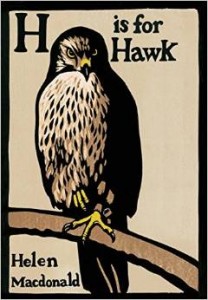 Published by Jonathan Cape 31 July 2014
Published by Jonathan Cape 31 July 2014
320pp, hardback, £14.99
Reviewed by Siân Miles
This extraordinary book is a rare and stunning composition: a trio of close harmony and resounding power combining biography, scientific paper, and elegy. If that sounds a bit uphill, read on, please.
The elegy is for a much-loved father; the scientific paper is on the training of a goshawk; the biography that of the relatively mature T.H.White, author amongst other works of The Sword in the Stone. The overarching and sometimes achingly beautiful theme linking all three aspects of H is for Hawk is how, and more importantly, how not to combine research with everyday life. In it, Helen Macdonald combines the scientist’s rigorous precision and accuracy with the inner vision of a true poet. It is a remarkable achievement and often a deep pleasure to read
The author’s late father was an acclaimed photo-journalist, brought up in post-war England where he and his friends played in bombsites and collected the ephemeral remains of ordinary domesticity; cigarette packages, bus tickets, etc., anything of which a desirable and hopefully complete series could be made. His own individual interest was in plane-spotting and he assembled, sometimes at his delighted peril, a compendium of notebooks recording every man-made thing he saw move in the sky. Macdonald sees this as a young group’s means of recreating and reascribing meaning to their physically shattered lives. She is clearly drawn and enchanted, in her dad’s case, by his early, later sustained and enduring attempt to occupy a bird’s eye view. Saint-Exupéry-like and with some of the latter’s spirituality, he imitates or aspires to the view sub specie aeternitatis; the aviator’s view. His relatively early and unexpected death, like his own experience of war, both devastates and later enriches his daughter’s understanding of peacetime.
She becomes an academic – he fondly refers to her as my daughter, the absent-minded professor – and teaches, at Cambridge, the history of science. In parallel to this trajectory, and having already become a competent falconer, immediately after her father’s death she adopts a goshawk, as similar to the sparrowhawk as leopard is to the household cat. By dint of near self-sacrificial rigour in its lengthy and painful training, she learns to come close to knowledge of all its mental and physical processes. Through their interaction over many often sleepless nights, weeks and months, she achieves invisibility and the longed-for capacity to forget herself; a welcome and comforting condition for a deeply grieving human.
Pivotal to Macdonald’s intellectual and physical understanding of this attempt to identify closely with another species is T.H.White’s The Goshawk on which she heavily relies for both information and support. He was a schoolmaster at Stowe and of necessity a closet homosexual. After a week-long consultation of his papers, now lodged in Austin, Texas, she makes strong connections between his attempt to enter the wild outside the ordered world of classical English tradition and her own frantic desire to escape the reality of deep and permanent loss. Cruelty and sadism are explored in the context of discipline and devotion.
All this goes on for 260 pages or so out of 300, couched in the most poetic, imaginative and richly persuasive prose. Macdonald’s sensitivity to English weather, landscape and natural habitat is extraordinary; she is a word-painter of the subtlest palette and an audiorecorder of peerless quality. The reader is transported, time after time, into scenarios whose dramatic intensity is matched only by the familiarity and diurnality of their settings.
If there is one thing which mars this treat of a book it is its organization. Towards its end, and in this reviewer’s opinion, late in the day, the dénouement finally comes. We learn that all the displacement activity of the goshawk-training, the exploration of White’s life, the attempt to move on is as nothing compared to the author’s final understanding that her father is dead and that she will neither see nor speak to him ever again. The entire book is a journey towards that acceptance. People die.
The ciphers with which she attempted to keep him alive fade into insignificance compared to the incontrovertible fact of death. Si le grain ne meurt. The comforting and sometimes dangerous Western myths of immortality and mutability so seductive to all are sidelined in favour of human and social solidarity.
